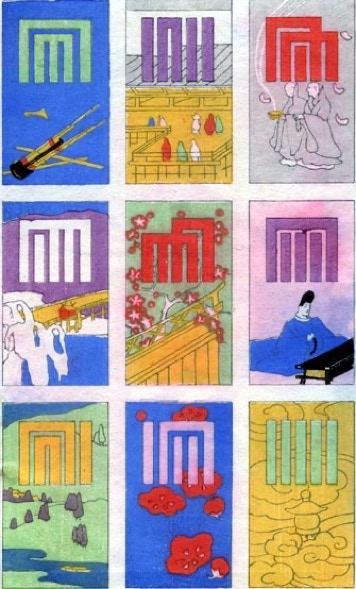Genji kō
There is a form of incense ceremony still practiced today known as Genji-kō (Genji incense). It is essentially a highly refined parlor game, based on one's ability to hold the olfactory memory of several different scents and tell them apart. The scoring system uses a set of symbols coded to 52 of the 54 chapters of The Tale of Genji. Despite the Heian-era overtones of its name, Genji-kō has nothing to do with the way incense was used during Murasaki's day. It comes, rather, from a tradition of incense guessing that was developed in the fourteenth century. The purpose of this later tradition, one that came to be codified into The Way of Incense (rather similar to The Way of Tea) was to appreciate and judge samples of individual aloeswoods. This was quite different from the emphasis on blending different ingredients that characterized the Heian interest in incense.
I was once invited to a Genji-kō party on a fall day in Kyoto. Twenty or so participants sat around the edges of an elegant tatami-matted room, while the host prepared five sets of aloeswood to be passed around in succession. In a tiny, ash-filled celadon censer, a fingernail-sized chip of rare wood perched atop the warm ash. This was passed from guest to guest, each one of us drinking in three whiffs before passing it on. This happened five times. Only the host knew, of the woods he prepared, which were different and which were the same. Our challenge was to try to discern the sameness or differentness of what we smelled, and write down our judgment using one of the Genji symbols.
These symbols, which have long since entered the realm of design motifs, are combinations of five vertical bars joined at the top by horizontal bars in different combinations. If the bars are connected, that means those scents are deemed the same. For example, five single vertical bars with no horizontals, would indicate that all five scents were different. This is represented by the design in the lower righthand corner of the sample of nine illustrations below. This corresponds to Chapter Two of The Tale of Genji, "The Broom Tree.
From upper left,the first picture shows a set in which the first scent and the fifth scent are the same, and the second, third and fourth are are the same. (The bars within the designs read from right to left, like Japanese text.) This set corresponds to Chapter 44, "Bamboo River."
The second design indicates a set in which the first and second scents are different, the third and fourth are the same, and the fifth is different. This design corresponds to Chapter 13, "Akashi."
The third design represents a case where the first and fourth scents are the same, the second and fifth are the same, and the third is different. This is Chapter 40, "The Rites."
You get the idea…

I have thought that this system would work nicely for a wine tasting, in which one substituted Cabernets for the different scents. . .